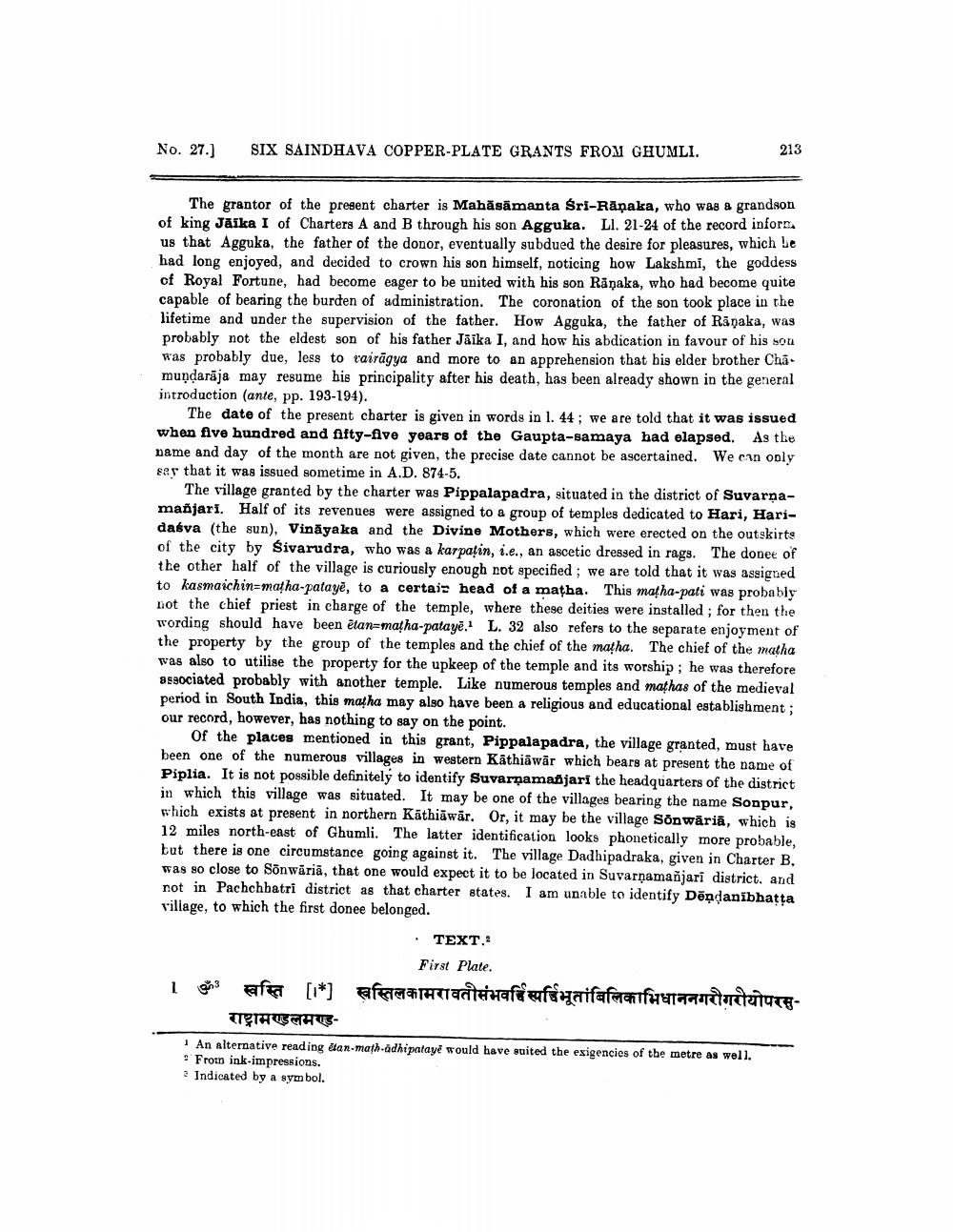________________
No. 27.)
SIX SAINDHAVA COPPER-PLATE GRANTS FROM GHUMLI.
213
The grantor of the present charter is Mahāsämanta Sri-Rāņaka, who was a grandson of king Jāika I of Charters A and B through his son Agguka. Ll. 21-24 of the record inforna us that Agguka, the father of the donor, eventually subdued the desire for pleasures, which be had long enjoyed, and decided to crown his son himself, noticing how Lakshmi, the goddess of Royal Fortune, had become eager to be united with his son Rāņaka, who had become quite capable of bearing the burden of administration. The coronation of the son took place in the lifetime and under the supervision of the father. How Agguka, the father of Ránaka, was probably not the eldest son of his father Jāika I, and how his abdication in favour of his son was probably due, less to vairāgya and more to an apprehension that bis elder brother Cha. mundarāja may resume his principality after his death, has been already shown in the general introduction (ante, pp. 193-194).
The date of the present charter is given in words in I. 44 ; we are told that it was issued when five hundred and fifty-five years of the Gaupta-samaya had elapsed. As the name and day of the month are not given, the precise date cannot be ascertained. We can only ees that it was issued sometime in A.D. 874-5.
The village granted by the charter was Pippalapadra, situated in the district of Suvarnamañjari. Half of its revenues were assigned to a group of temples dedicated to Hari, Haridaśva (the sun), Vināyaka and the Divine Mothers, which were erected on the outskirts of the city by Sivarudra, who was a karpatin, i.e., an ascetic dressed in rags. The donee of the other half of the village is curiously enough not specified; we are told that it was assigned to kasmaichin=matha-patayē, to a certaic head of a matha. This matha-pati was probably not the chief priest in charge of the temple, where these deities were installed; for then the wording should have been étan=matha-pataye. L. 32 also refers to the separate enjoyment of the property by the group of the temples and the chief of the matha. The chief of the matha was also to utilise the property for the upkeep of the temple and its worship; he was therefore associated probably with another temple. Like numerous temples and mathas of the medieval period in South India, this matha may also have been a religious and educational establishment; our record, however, has nothing to say on the point.
Of the places mentioned in this grant, Pippalapadra, the village granted, must have been one of the numerous villages in western Käthiāwār which bears at present the name of Piplia. It is not possible definitely to identify Suvarnamañjari the headquarters of the district in which this village was situated. It may be one of the villages bearing the name Sonpur, which exists at present in northern Käthiāwār. Or, it may be the village Sõnwäriä, which is 12 miles north-east of Ghumli. The latter identification looks phonetically more probable, but there is one circumstance going against it. The village Dadhipadraka, given in Charter B. was so close to Sõnwăriā, that one would expect it to be located in Suvarnamañjari district, and not in Pachchhatri district as that charter states. I am unable to identify Dēndanibhatta village, to which the first donee belonged.
• TEXT.:
First Plate. । ॐ स्वस्ति [*] स्वस्तिलकामरावतीसंभवस्पिर्धिभूतांबिलिकाभिधाननगरौगरीयोपरम
राष्ट्रामण्डलमण्ड
1 An alternative reading etan-math-adhipataye would have suited the exigencies of the metre as well. . From ink-impressions. 2 Indicated by a symbol.




